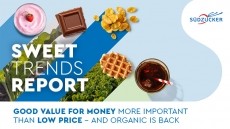Capturing ammonia: Materials to catch this crucial chemical

The chemical ammonia has many uses, a myriad of which are in the food industry. These uses are often vital to certain processes.
A new study looks at some of the different ways in which ammonia can be captured.
What is ammonia and how is it used in the food industry?
Ammonia is a colourless gas around half the weight of air, with a strong smell similar to urine. It has many uses, including in dyes, synthetic fibres, plastics, pharmaceuticals and explosives.
It has many uses in the food industry. For example, it is often used in food safety, and courted controversy in the US when it was sprayed on beef to avoid contamination by salmonella or E. coli.
It is used in baked goods as a leavening agent, and in cheese and chocolate as an acidity controller.
It is also a significant component of fertilisers, the mass production of which was made possible by the Haber Bosch process. Thus, it is a significant component of feeding the world.
Capturing ammonia
Ammonia is also emitted from several agricultural processes, as well as compost. Capturing it can enable it to be used more stringently.
The study explored the best ways of capturing it. Traditional methods include physical condensation, which relies on a boiling point difference to separate ammonia by liquifying it while other gasses in a compound remain gaseous, and water or acid scrubbing, which relies on different solubilities of gasses in liquid solvents to achieve gas separation. However, water scrubbing produces secondary pollution, and acid presents practical challenges.
The Haber Bosch Process
The Haber Bosch process was developed by German physical chemist Fritz Haber. The process, which enables one to directly synthesise ammonia from hydrogen and nitrogen, was later upscaled by Carl Bosch.
The Haber Bosch process made it possible to produce fertiliser on a massive scale, making it possible to feed exponentially more people and ballooning the world’s population. Both Haber and Bosch were awarded Nobel Prizes for the innovation (controversially in Haber’s case, due to his role in developing poisonous gasses in the First World War).
The researchers aimed to create green solutions to the problem of ammonia capture, looking at potential materials that could do the job.
One such material is ionic liquids, which are liquids made up of ions, atoms or group of atoms with an electric charge. They are useful because of their low volatility, high stability, good gas solubility, and the fact that they can be designed according to the requirements of their application.
Porous solid absorbents are also useful in capturing ammonia. The pores in these solids provide transport channels to capture ammonia. Using this material avoids the potential corrosion caused by acid washing. There are four types of these materials with varying absorption capacities.
Porous liquids have all the benefits of porousness, but with the flexibility of a liquid. They contain permanent cavities that act as gas transport pathways, although these cavities are unstable. No porous liquids have yet been designed for ammonia capture, but this, the study suggested, could be a topic for future study.
Finally, membrane materials can allow for the direct recovery of gaseous ammonia. However, unlike in the case of CO2, research on this for ammonia is limited.
Following the study, the researchers hope to use artificial intelligence to better predict the ability of each material to absorb ammonia.
Sourced From: Nano-Micro Letters
'Advanced Materials for NH3 Capture: Interaction Sites and Transport Pathways'
Published on: 27 June 2024
Doi: https://doi.org/10.1007/s40820-024-01425-1
Authors: H. Jiang, Z. Wang, X. Sun, S. Zeng, Y. Guo, L. Bai, M. Yao & X. Zhang






















